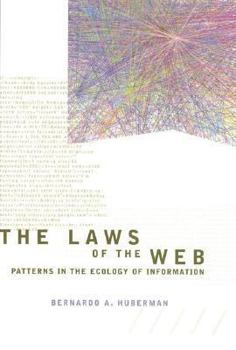The Laws of the Web: Patterns in the Ecology of Information
Select Format
Select Condition 
Book Overview
An accessible explanation of the hidden patterns found within the seemingly chaotic World Wide Web. Despite its haphazard growth, the Web hides powerful underlying regularities--from the organization of its links to the patterns found in its use by millions of users. Many of these regularities have been predicted on the basis of theoretical models based on a field of physics--statistical mechanics--that few would have thought applicable to the social domain. In this book, Bernardo Huberman explains in accessible language the laws of the Web. One of the foremost researchers in the field, Huberman has established, for example, that the surfing patterns of individuals are describable by a precise law. Such findings can lead to more efficient Web design and use. They also shed light on social mechanisms whose significance goes beyond the Web. In this sense, the Web is a gigantic informational ecosystem that can be used to quantify and test explanations of human behavior and social interaction.
Format:Paperback
Language:English
ISBN:0262582252
ISBN13:9780262582254
Release Date:April 2001
Publisher:MIT Press
Length:116 Pages
Weight:0.35 lbs.
Dimensions:8.0" x 0.3" x 5.4"
Age Range:18 years and up
Grade Range:Postsecondary and higher
Customer Reviews
5 ratings
Great Book
Published by Thriftbooks.com User , 18 years ago
Although dated, this book still has useful information. It is an expose' on social aspects of the web and the author's opinion of why, how and when things occur. Also, the author discusses how to benefit.
Underappreciated book
Published by Thriftbooks.com User , 19 years ago
This is a really good book and is underappreciated in the community. It is one of the first - before Barabasi - that noted the commonality of laws guiding the organization of large emergent systems.
cool book
Published by Thriftbooks.com User , 22 years ago
brief book is very interesting... full of intersting obervations about human-computer interaction and information seeking via the web.
A fresh perspective to understand the web
Published by Thriftbooks.com User , 23 years ago
In this book, the author introduces results of research that shows there are surprising strong global regularities present on the web resulting from the local browsing behavior of agents. He explains in simple terms and well-chosen familiar examples, key ideas to understand how these regularities come about. The ideas and the regularities described in every chapter are backed by refereed papers from the author and his associates that have appeared over the years (in Science, Nature, ...) and that I would recommend the technically inclined reader to look into. As the author takes the reader through the different chapters, he introduces in simple terms the methodology of study and analysis borrowed from the physical sciences (to study the dynamics of large number of interacting particles) which in my case it was very helpful as I am trained in computer science where we do not get exposed to those techniques. The regularities are explained by way of interesting models (e.g., social dilemmas, six-degrees of separation, Brownian motion, etc.) that make for a refreshing reading.The author goes further than just presenting and explaining the results as he gives very practical applications where knowing these regularities can help the design of better algorithms, web sites and systems. Among some of the results presented are: a law that can predict how far users will go on clicking on pages of a given site, the existence of `internet storms' where the net becomes very slow even though there is no obvious event that caused it (like when sometimes in a highway you slowdown to a halt even though there does not seem to be any accident), a law that predicts the distribution of the sizes (in pages) of web sites and several other regularities. Among one of the clever applications described is an algorithm that figures out when to wait or request again for a web page so that the user on average downloads it faster.
''The Laws of Web'' is outstanding!
Published by Thriftbooks.com User , 24 years ago
Huberman's book is a remarkably novel way of looking at theWeb. With simple and well developed examples, Hubermanprovides a clear description of hidden structures existingin Web. It's a book that is useful for both curious readersand researchers. Readers interested in understanding the use of information by society, including ways of searching, organizing, and interacting with large information systems must read this book.






